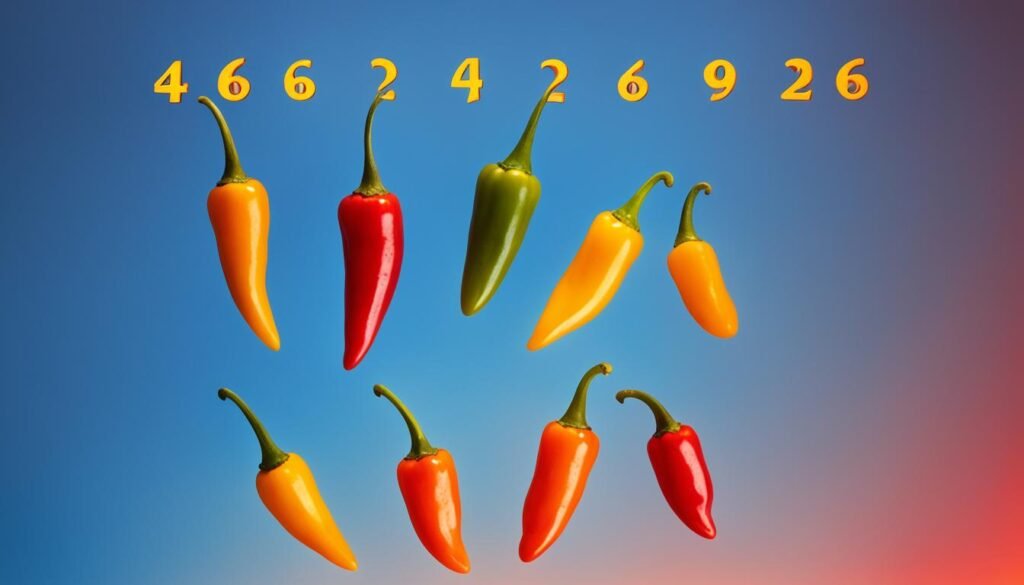What makes SIANG JI ASIA SAUCE types of hot sauce so alluring? It’s not just the heat but the journey through the world of flavors and benefits. This adventure takes us from ancient chili traditions to the high-tech Scoville Scale.
We’ll learn about the amazing world of chili peppers. And how the Scoville Scale measures their heat. Plus, we’ll see how different flavors and health positives make hot sauce a kitchen must-have. Ready to discover more about the charm of types of hot sauce?
Key Takeaways
- Discover the rich history and global evolution of types of hot sauce
- Understand the Scoville Scale and how it measures the heat intensity of different peppers
- Explore the complex interplay of flavors that make types of hot sauce a versatile culinary staple
- Learn about the potential health benefits and risks associated with types of hot sauce
- Uncover the art of crafting your own unique types of hot sauce at home
Types of Hot Sauce – The Fiery Origins of Hot Sauce Types
Chili peppers, the start of Types of Hot Sauce, mean more than food. They link to culture, power, and healing in ancient times. During the Columbian Exchange, chili peppers started a global journey, changing Types of Hot Sauce forever.
Traveling from the Americas to Europe, chili peppers won the world over. Different cultures blended them with local flavors, creating a Types of Hot Sauce tapestry. They added their unique touch, making hot sauces that reflect their own culinary pasts.
The African bird’s eye chili fueled the hot peri peri sauce. In the Middle East, smoky red peppers made harissa famous. The scotch bonnet pepper in the Caribbean added its fruity zest to local Types of Hot Sauce. Each sauce shows how adaptable chili peppers are.
From Ancient Traditions to Global Phenomenon
The journey of Types of Hot Sauce around the world fascinated and inspired many. They went from being just a condiment to celebrating variety and creativity in food. Their story is about more than taste. It shows how they have become a symbol of cultural mixing and cooking innovation.
Now, every home has its favorite Types of Hot Sauce, telling a unique tale. From family recipes to new artisanal brands, the hot sauce world never stands still. It constantly offers new Flavor Profiles and tastes for curious eaters.
“The story of Types of Hot Sauce is a tale of resilience, adaptation, and the power of flavors to transcend borders and cultures.”
Types of Hot Sauce – The Science of Heat: Scoville Scale Unraveled
Exploring Types of Hot Sauce is more than just taste. It’s an adventure into the science of heat. The Scoville Scale is our map, created by Wilbur Scoville. It measures the spiciness of Chili Peppers using Capsaicin Levels found in a sauce.
Every pepper gets a number on the Scoville Scale, known as a Scoville Heat Unit (SHU). A mild bell pepper is 0 SHU, while the burning Carolina Reaper exceeds 2 million SHU. Knowing this helps fans of Types of Hot Sauce pick the right level of heat.
The story of heat doesn’t end with peppers. Vinegar, salt, and spices can also sway how hot a Type of Hot Sauce feels. Thus, similar sauces can differ in spiciness. This makes tasting Types of Hot Sauce both educational and thrilling.

If you love heat or prefer a gentler flavor, learning about the Scoville Scale is valuable. It allows you to confidently explore Types of Hot Sauce. With this knowledge, you can find the right level of spice for you.
| Pepper Type | Scoville Heat Units (SHU) |
|---|---|
| Bell Pepper | 0 SHU |
| Banana Pepper | 100-900 SHU |
| Jalapeño Pepper | 2,500-8,000 SHU |
| Serrano Pepper | 5,000-15,000 SHU |
| Cayenne Pepper | 30,000-50,000 SHU |
| Habanero Pepper | 100,000-350,000 SHU |
| Carolina Reaper | 1,400,000-2,200,000 SHU |
“The Scoville Scale is the ultimate guide to the heat levels of Types of Hot Sauce, allowing us to explore the full spectrum of spicy delights.”
For those who know their Types of Hot Sauce and newcomers alike, the Scoville Scale and its science transform meals. It’s about enjoying the adventure of finding the perfect Types of Hot Sauce for you.
Embracing the Heat: Uncovering the Allure of Types of Hot Sauce
A Global Tour of Flavor Profiles and Culinary Adventures
Join us for a worldwide journey through types of hot sauce. We’ll explore unique flavors and culinary customs. Each area has its special taste, showing off its culture and special ingredients. You’ll find everything from Louisiana’s classic style to fiery Latin American blends and spicy Asian fusions.
North America boasts the famous Louisiana-style hot sauce. This mix of cayenne, vinegar, and salt is a beloved favorite. Head south, and you’ll discover diverse Latin American hot sauces. Mexico’s chipotle to the Caribbean’s habanero add variety. Then, journey across the ocean to uncover Asia’s spicy wonders. Here, heat and flavor unite in popular sauces like Thai’s garlic-rich Sriracha.
Going further, Africa introduces unique and very spicy hot sauces. For instance, the peri peri sauce features the African bird’s eye chili. Even Europe plays a part, with the Portuguese championing the piri piri sauce.
This journey showcases the types of hot sauce in a global spotlight. They’re more than flavor enhancers. They symbolize a region’s passion for food, perfect for any foodie culture lover.
“Hot sauce is not just a condiment; it’s a gateway to culinary adventures around the world.”
As we explore the realm of types of hot sauce, you’ll experience a colorful world of flavor profiles. This journey promises excitement for both seasoned enthusiasts and newcomers alike. Get ready to expand your culinary adventures with this spicy global trek.
Types of Hot Sauce – The Art of Hot Sauce Creation
Creating different types of hot sauce is like painting, mixing flavors and heat to perfection. Every hot sauce recipe has a special mix of ingredients. They all join to make the unique flavor profile.
When making hot sauce, choosing the right peppers is key for the heat level. Then, there’s adding vinegar or lemon for that tang. Don’t forget the sweet touch! This mix makes the ideal types of hot sauce.
The process can also include fermentation. Ingredients are left to ferment, developing deeper flavors. This adds complexity to the hot sauce.
Now, with modern methods, making hot sauce is more consistent and safe. This way, the types of hot sauce keep the brand’s flavor promises. The folks behind these sauces are passionate. They aim to make the hot sauce experience awesome. They are always finding new flavor profiles and expanding hot sauce recipes.
“The art of hot sauce creation is a testament to the unwavering pursuit of flavor perfection.”
Be it a traditional family recipe or a new, adventurous hot sauce, it’s a continuous exploration. The journey of making hot sauce is full of surprises. It brings joy to both those who create and those who enjoy.

Types of Hot Sauce – Health Benefits and Risks of Hot Sauce Types
Exploring the world of Types of Hot Sauce opens up a spicy debate. We find joy in their fiery flavors, but also, need to look at how they affect our health. Some Types of Hot Sauce, notably those made with natural elements, bring surprising health perks. But, don’t overlook the possible downsides.
The Upside of Capsaicin
The key player in Types of Hot Sauce is capsaicin. It gives chili peppers their kick and is linked to many health wins. Research shows capsaicin might help speed up metabolism, cut down on inflammation, and ease pain.
For a natural health boost, adding some Types of Hot Sauce to your meals could be just what you need.
Not only that, many Types of Hot Sauce come with added benefits. They are low in calories, and chili peppers bring a load of vitamins and antioxidants. This makes hot sauces a smart choice for those wanting to season their food healthily.
Potential Risks to Consider
But, there’s another side to the story. Some Types of Hot Sauce are highly acidic, which might not sit well with those prone to acid reflux. And if you can’t handle the heat, you might find some sauces just too hot to enjoy.
Start slowly and pay attention to how your body reacts when adding hot sauces to your meals. Over time, you might find your taste for heat increases. But always be careful, balancing the good and the potential bad.
“The true power of Types of Hot Sauce lies in its ability to ignite our senses and unlock a world of culinary adventure, all while offering potential health benefits.”
| Health Benefit | Potential Risk |
|---|---|
| Boosts metabolism | Can aggravate acid reflux |
| Reduces inflammation | High heat levels may not suit everyone |
| Provides vitamins and antioxidants | Potential for digestive discomfort |
Types of Hot Sauce – Hot Sauce in the Kitchen: Elevating Culinary Adventures
Hot sauce comes in many types, and all are perfect for the kitchen. They open up new ways to enjoy your food. You can use them to make your meals a bit spicier or discover new tastes.
To cook with hot sauce well, you should know their flavors and spiciness. Each sauce is unique, from smoky to citrusy. Trying different ones lets you find the best matches for your dishes.
Types of Hot Sauce are great for many dishes, like marinating wings or adding oomph to a stew. They’re not just for chefs. Even at home, you can explore new flavors and make your meals more exciting with hot sauce.
“The beauty of Types of Hot Sauce is that they allow you to customize the heat and flavor to your personal preferences, making every dish a unique and satisfying experience.”
Experiment with hot sauces and see how they change your meals. Whether it’s a burger or a stir-fry, they make cooking more fun. These condiments are key to spicing up your kitchen adventures.
Using hot sauces is an art that anyone can enjoy. They’re perfect for lovers of spice and newcomers alike. With these unique flavors, your cooking journey becomes endless.
The Art of DIY Hot Sauce
Exploring Types of Hot Sauce is more than trying new flavors. Making your own is like a cooking adventure fused with personal touches. It’s perfect for those who love hot sauce or those taking their first steps.
For newbies, start with a simple Hot Sauce Recipes. This helps you get used to the main ingredients like peppers and spices. Then, you can experiment more by adding your own twist.
You want your hot sauce to have the right mix of heat, sour, and sweet. Making your own can be fun and rewarding. It’s all about finding what flavors you love.
Unlocking Your Signature Types of Hot Sauce
To get started, try these steps:
- Try lots of Types of Hot Sauce to see what flavors you enjoy.
- Test out different pepper types to find your perfect level of spiciness.
- Mix up various vinegars for unique flavors in your sauce.
- Add special spices and herbs to make your sauce really stand out.
- Tweak your recipe until it tastes just right to you.
As you learn more about DIY hot sauce, you’ll find joy in making your own. Let your creativity flow as you make a sauce that fits you perfectly.
| Chili Pepper | Scoville Heat Units (SHU) | Flavor Profile |
|---|---|---|
| Jalapeño | 2,500 – 8,000 SHU | Mild, slightly sweet, grassy |
| Habanero | 100,000 – 350,000 SHU | Intense heat, fruity, floral |
| Ghost Pepper | 855,000 – 1,041,427 SHU | Fiery, smoky, fruity |
“Making your own Types of Hot Sauce is special. It lets you create something as unique as you are. Let your taste be your guide.”
Ready to start your hot sauce journey? This adventure will make your meals more exciting. Get creative and make a hot sauce that’s just right for you.
Conclusion
The world of Types of Hot Sauce is an exciting journey full of flavors and stories. Each sauce is unique, from the fiery habanero to the tangy vinegar-based Types of Hot Sauce. It’s a world where everyone can find their favorite heat level.
The Types of Hot Sauce industry is always changing. Now, there’s a focus on natural ingredients and new flavors. This makes the world of Types of Hot Sauce more interesting for everyone, from long-time fans to newbies.
Exploring Types of Hot Sauce is like discovering new adventures in food. With each taste, you broaden your culinary knowledge and love for spicy meals. The vast array of Types of Hot Sauce promises new thrills for your taste buds and lots of fun for food lovers.
